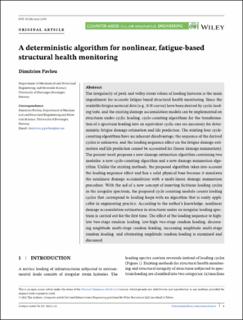| dc.contributor.author | Pavlou, Dimitrios | |
| dc.date.accessioned | 2023-03-02T08:19:00Z | |
| dc.date.available | 2023-03-02T08:19:00Z | |
| dc.date.created | 2021-11-24T10:29:51Z | |
| dc.date.issued | 2021-10 | |
| dc.identifier.citation | Pavlou, D. (2022) A deterministic algorithm for nonlinear, fatigue-based structural health monitoring. Computer-Aided Civil and Infrastructure Engineering, 37(7), 1-23. | en_US |
| dc.identifier.issn | 1093-9687 | |
| dc.identifier.uri | https://hdl.handle.net/11250/3055172 | |
| dc.description.abstract | The irregularity of peak and valley stress values of loading histories is the main impediment for accurate fatigue-based structural health monitoring. Since the available fatigue material data (e.g., S-N curves) have been derived by cyclic loading tests, and the existing damage accumulation models can be implemented on structures under cyclic loading, cycle-counting algorithms for the transformation of a spectrum loading into an equivalent cyclic one are necessary for deterministic fatigue damage estimation and life prediction. The existing four cycle-counting algorithms have an inherent disadvantage; the sequence of the derived cycles is unknown, and the loading sequence effect on the fatigue damage estimation and life prediction cannot be accounted for (linear damage summation). The present work proposes a new damage estimation algorithm containing two modules: a new cycle-counting algorithm and a new damage summation algorithm. Unlike the existing methods, the proposed algorithm takes into account the loading sequence effect and has a solid physical base because it simulates the nonlinear damage accumulation with a multi-linear damage summation procedure. With the aid of a new concept of inserting fictitious loading cycles in the irregular spectrum, the proposed cycle counting module counts loading cycles that correspond to loading loops with an algorithm that is easily applicable in engineering practice. According to the author's knowledge, nonlinear damage accumulation estimation in structures under an irregular loading spectrum is carried out for the first time. The effect of the loading sequence to high-low two-stage random loading, low-high two-stage random loading, decreasing amplitude multi-stage random loading, increasing amplitude multi-stage random loading, and alternating amplitude random loading is examined and discussed. | en_US |
| dc.language.iso | eng | en_US |
| dc.publisher | Wiley Periodicals LLC | en_US |
| dc.rights | Navngivelse 4.0 Internasjonal | * |
| dc.rights.uri | http://creativecommons.org/licenses/by/4.0/deed.no | * |
| dc.subject | teknologi | en_US |
| dc.title | A deterministic algorithm for nonlinear, fatigue-based structural health monitoring | en_US |
| dc.type | Peer reviewed | en_US |
| dc.type | Journal article | en_US |
| dc.description.version | publishedVersion | en_US |
| dc.rights.holder | © 2021 The Author(s). | en_US |
| dc.subject.nsi | VDP::Teknologi: 500 | en_US |
| dc.source.pagenumber | 1-23 | en_US |
| dc.source.volume | 37 | en_US |
| dc.source.journal | Computer-Aided Civil and Infrastructure Engineering | en_US |
| dc.source.issue | 7 | en_US |
| dc.identifier.doi | 10.1111/mice.12783 | |
| dc.identifier.cristin | 1958260 | |
| cristin.ispublished | true | |
| cristin.fulltext | original | |
| cristin.qualitycode | 1 | |

